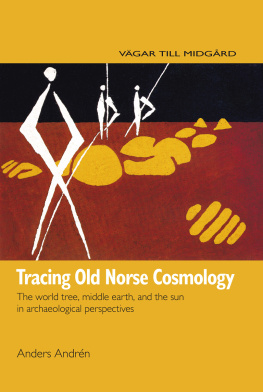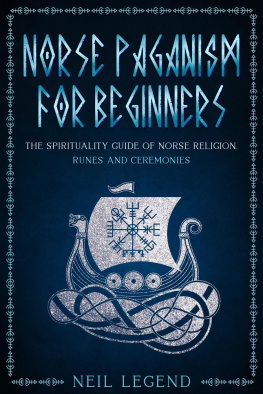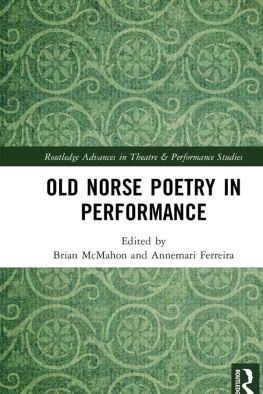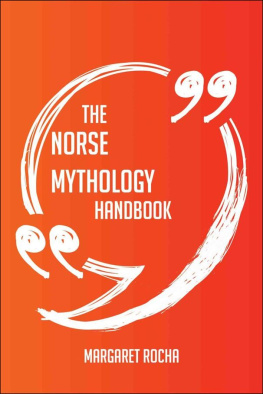CHAPTER 1
Old Norse cosmology as an archaeological challenge
Young were the years when Ymir made his settlement,
there was no sand nor sea nor cool waves;
earth was nowhere nor the sky above,
chaos yawned, grass was there nowhere.
This is the famous description near the beginning of the Icelandic Eddic poem Vlusp (The Seeresss Prophecy) of the empty void before the creation of an ordered world. The following stanzas tell how the gods gave everything in the world its name and right place, how they built ritual sites and made precious objects, and how they blew life into the first humans from two pieces of wood. After descriptions of the world tree and the first war between the two families of gods, the sir and the Vanir, the poem ends with the death of the god Baldr and the destruction of the world, Ragnarok (Ragnark), literally the destiny of the gods. However, the poem states that after Ragnarok a new eternally green world will come from the sea, and in the grass the children of the old sir gods will find the wonderful golden chequers, those which they possessed in the ancient times (Vlusp 59, 61).
The ordered world in Vlusp was usually called Midgard (Migarr), meaning dwelling place in the middle (Simek 1993:214). This concept was known not only in Iceland, where Vlusp was composed probably in the eleventh century (McKinnell 2008), but also in other areas of the Germanic-speaking world. As early as AD 370, in Bishop Wulfilas Gothic translation of the Bible, the same concept is rendered as midjungards. Other later but similar forms are known from Saxon, Old English, and Old High German. In Scandinavia, the earliest reference to Midgard comes from a runic inscription on a boulder at Fyrby in Sdermanland in central Sweden, dated to the early eleventh century (de Vries 1957:3723; Vikstrand 2006). An alternative name for the world, Jormungrund (Jrmungrundr) meaning mighty ground, also existed. It is recorded in Grmnisml 20, but also in Beowulf 859 and on the famous rune stone at Karlevi on land in eastern Sweden () from about the year 1000 (Simek 1993:180).
Today, notions of an ordered universe are usually framed by the concept cosmology. The word, meaning knowledge of good order, was first coined by the German Enlightenment philosopher Christian Wolff (16791754) in his Cosmologia Generalis from 1731. Since then, the word has been given many different uses and meanings. One of the modern uses of the word is anthropological, being a general concept of different culturally constructed worldviews. Cosmology in this sense usually includes fundamental notions regarding time and space, the structure of the universe, the creation of the world, borders between supernatural powers and humans, origins of social groups, divisions between men and women, fate and death, ethics, and the criteria of truth. In several cultures, these different cosmological aspects are linked to one another in a cosmological system, as in the case of the Chinese principles of yin and yang (for example Douglas 1966; Geertz 1973; Clunies Ross 1994:42 ff.; Raudvere 2004).
Cosmology is accordingly a modern concept, like the concept of religion itself. Both words are modern attempts to define certain aspects of human action and human thought in time and space. Cosmology is not necessarily connected to religion, but in most pre-modern societies religious myths provided answers to many of the fundamental cosmological questions. A coherent worldview is seldom presented in these myths, and should not be expected, since cosmology is a modern concept. However, some general principles can often be deduced from the narratives (Raudvere 2004).
Cosmology can also be connected to rituals, since ritual sites and monuments in many cultures seem to have been modelled in accordance with aspects of different worldviews (Widengren 1969:340 ff.; Sundqvist 2004). In that sense, cosmology is a concept situated between the concepts of myth and ritual, since it can be connected to both. This conceptual location of cosmology is important, especially in current reconsiderations of ritual, myth, and religion.
Previously, myths were regarded as the core of religion, whereas rituals were often perceived as passive expressions of myths and actions designed to maintain a cosmological order (Eliade 1958). In recent decades, however, these perspectives have been challenged in anthropological criticism of the implicit Judeo-Christian background of many religious studies (Smith 1987; Asad 1993; Bell 1992; Humphrey and Laidlaw 1994; Rappaport 1999; Habbe 2005). Religion is no longer defined as theology, but is viewed much more as changing social practice, associated with a religious transcendental discourse. Myth and ritual are understood as two different but interrelated social categories. As a consequence, ritual is not necessarily regarded as a representation of myth, but can be apprehended as a formalized act that in itself creates meaning. Instead of merely maintaining a cosmological order, ritual is also seen as a transformative act. Besides, ritual is not regarded as necessarily religious, since it can refer to other legal, political, and social discourses (Nilsson Stutz 2003; Habbe 2005). Myth, meanwhile is still regarded as an important narrative, but in recent years above all its social functions have been underlined (Meulengracht Srensen 1993; Clunies Ross 1994; Lindow 1997a).
Nonetheless, in those cases where ritual and myth can be related, cosmology may still play an important intermediate role. Cosmology is never limited to a single medium, but is usually played out in different myths as well as in ritual sites. This interface does not necessarily lead in a single direction. Ritual sites might be expressions of cosmological ideas, but it is also possible that the sites and monuments themselves created and reinforced cosmological notions. For example, the divine abodes of Old Norse gods and goddesses were expressed through, but also modelled on, the large halls that the political elite in Scandinavia used in the Iron Age (Hedeager 2011:148 ff.).
Still, since current ritual theory is above all based on the theory of practice (see Bourdieu 1990), questions concerning the history and meaning of rituals in long-term perspectives are to a large extent lacking in todays debate. Similarly, it is noteworthy that material culture plays a minor role in much current ritual theory, since objects are conceived of as symbols in a traditional semiotic, sense. This means that objects are viewed as empty symbols, without any fundamental importance for the understanding of religion (Kyriakidis 2007). However, in recent religious studies inspired by cognitive science, material culture has been fully incorporated into investigations of religion. A good example is the work of Johan Mode, who underlines the fundamental role of objects, buildings, and places in religion. According to Mode (2005), without them, religion is not conceivable and would not exist as a social practice.
Cosmological aspects of Old Norse religion
Old Norse religion is the conventional name for religious traditions in Scandinavia before the conversion to Christianity in the tenth and eleventh centuries. Pre-Christian religion in Scandinavia was above all based on ritual practice and oral traditions, although runic writing has been used in northern Europe since about AD 200. This means that almost all written accounts of these religious traditions are external, written either by Christians referring back to their pagan past or by foreigners from ethnographical perspectives.
Most written accounts of Old Norse religion come from the rich and varied medieval Icelandic literature. The mythological world is summarized and explained in Snorris Edda, a poetic manual written by the Icelandic chieftain and skald (poet) Snorri Sturluson (11791241) in the early thirteenth century. He based his knowledge on a large corpus of skaldic poems, some lost, some preserved in fragments, and some extant in their full length. The most important surviving mythological and heroic poems are collected in the
Next page








